Principles and Methods in Identifying Mental Health Disorders Explored
VerifiedAdded on 2023/06/15
|6
|1499
|215
Essay
AI Summary
This essay delves into the principles and methods used to identify mental health disorders, highlighting the inherent challenges, the impact of social norms, and the pervasive stigma associated with these conditions. It underscores the bio-psycho-social model's role in understanding the multifaceted causes of mental disorders, including biological, psychological, and social factors. The essay addresses the difficulties in diagnosing mental disorders, such as the absence of definitive medical tests and the frequent co-occurrence of multiple disorders. It further explores how social norms and cultural beliefs shape perceptions of abnormal behavior, contributing to stigma and discrimination. The essay also discusses various identification methods, including physical examinations, laboratory tests, and psychological evaluations, emphasizing the importance of addressing social stigma and promoting education to improve diagnosis and treatment outcomes. Desklib offers this assignment solution and many other resources for students.
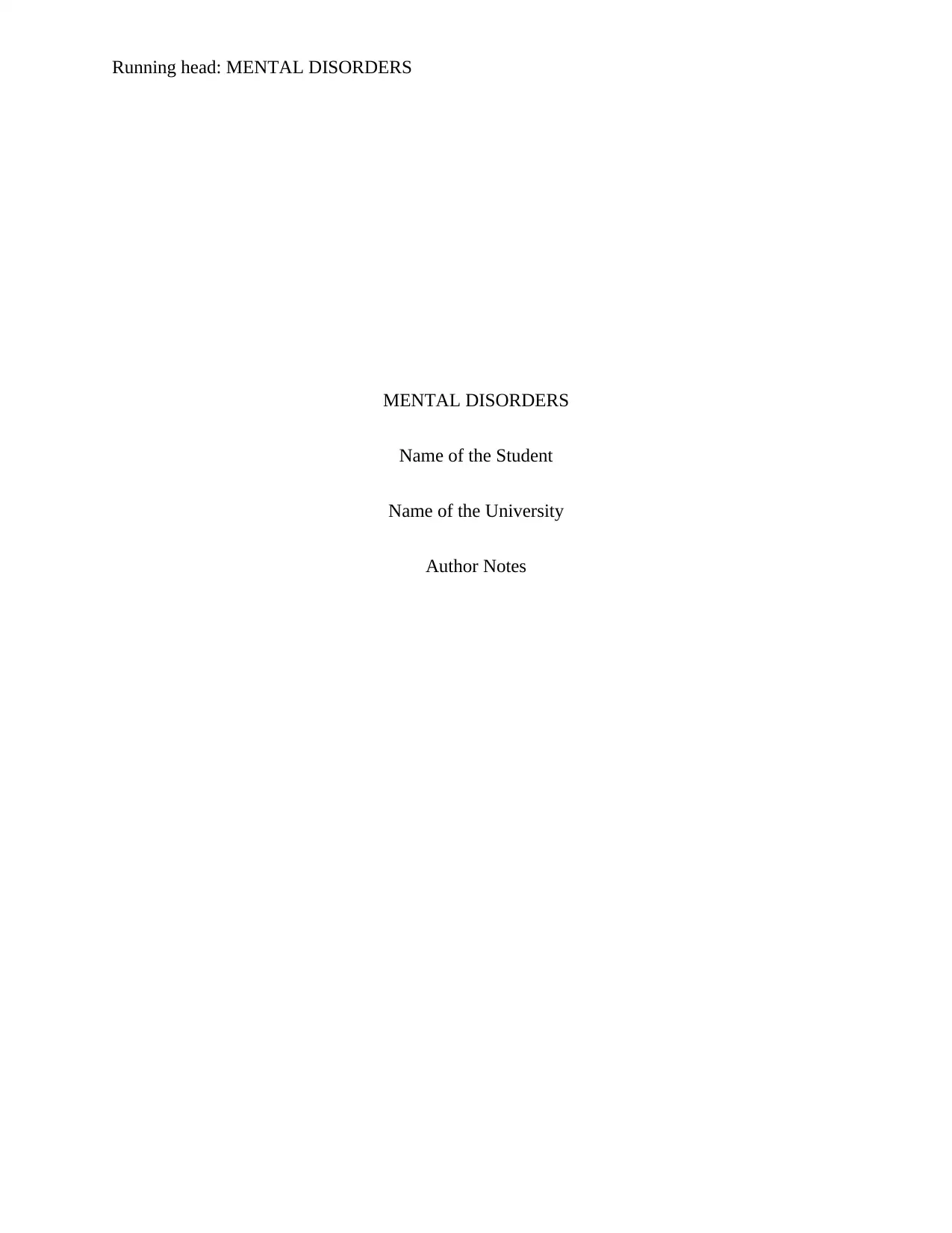
Running head: MENTAL DISORDERS
MENTAL DISORDERS
Name of the Student
Name of the University
Author Notes
MENTAL DISORDERS
Name of the Student
Name of the University
Author Notes
Paraphrase This Document
Need a fresh take? Get an instant paraphrase of this document with our AI Paraphraser
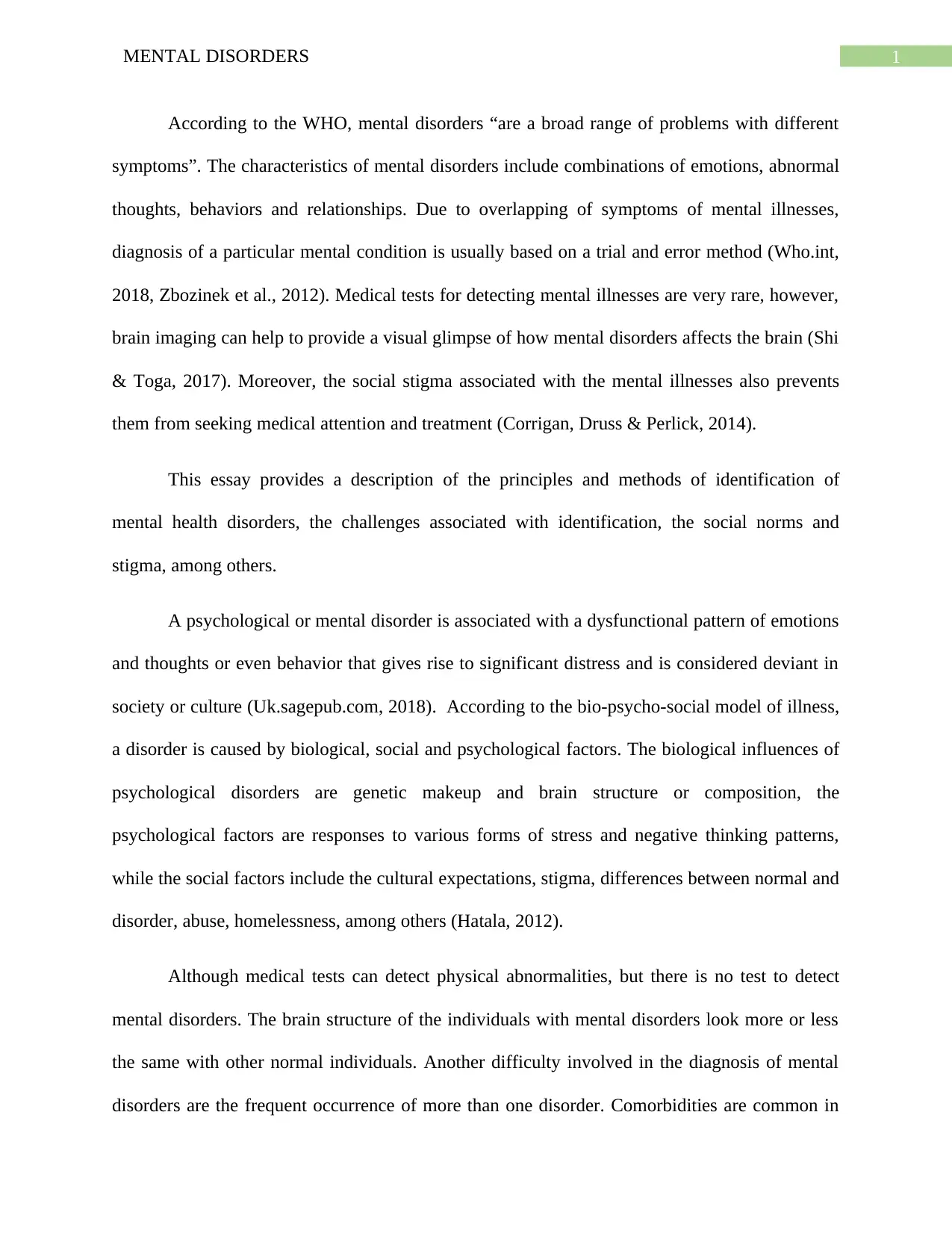
1MENTAL DISORDERS
According to the WHO, mental disorders “are a broad range of problems with different
symptoms”. The characteristics of mental disorders include combinations of emotions, abnormal
thoughts, behaviors and relationships. Due to overlapping of symptoms of mental illnesses,
diagnosis of a particular mental condition is usually based on a trial and error method (Who.int,
2018, Zbozinek et al., 2012). Medical tests for detecting mental illnesses are very rare, however,
brain imaging can help to provide a visual glimpse of how mental disorders affects the brain (Shi
& Toga, 2017). Moreover, the social stigma associated with the mental illnesses also prevents
them from seeking medical attention and treatment (Corrigan, Druss & Perlick, 2014).
This essay provides a description of the principles and methods of identification of
mental health disorders, the challenges associated with identification, the social norms and
stigma, among others.
A psychological or mental disorder is associated with a dysfunctional pattern of emotions
and thoughts or even behavior that gives rise to significant distress and is considered deviant in
society or culture (Uk.sagepub.com, 2018). According to the bio-psycho-social model of illness,
a disorder is caused by biological, social and psychological factors. The biological influences of
psychological disorders are genetic makeup and brain structure or composition, the
psychological factors are responses to various forms of stress and negative thinking patterns,
while the social factors include the cultural expectations, stigma, differences between normal and
disorder, abuse, homelessness, among others (Hatala, 2012).
Although medical tests can detect physical abnormalities, but there is no test to detect
mental disorders. The brain structure of the individuals with mental disorders look more or less
the same with other normal individuals. Another difficulty involved in the diagnosis of mental
disorders are the frequent occurrence of more than one disorder. Comorbidities are common in
According to the WHO, mental disorders “are a broad range of problems with different
symptoms”. The characteristics of mental disorders include combinations of emotions, abnormal
thoughts, behaviors and relationships. Due to overlapping of symptoms of mental illnesses,
diagnosis of a particular mental condition is usually based on a trial and error method (Who.int,
2018, Zbozinek et al., 2012). Medical tests for detecting mental illnesses are very rare, however,
brain imaging can help to provide a visual glimpse of how mental disorders affects the brain (Shi
& Toga, 2017). Moreover, the social stigma associated with the mental illnesses also prevents
them from seeking medical attention and treatment (Corrigan, Druss & Perlick, 2014).
This essay provides a description of the principles and methods of identification of
mental health disorders, the challenges associated with identification, the social norms and
stigma, among others.
A psychological or mental disorder is associated with a dysfunctional pattern of emotions
and thoughts or even behavior that gives rise to significant distress and is considered deviant in
society or culture (Uk.sagepub.com, 2018). According to the bio-psycho-social model of illness,
a disorder is caused by biological, social and psychological factors. The biological influences of
psychological disorders are genetic makeup and brain structure or composition, the
psychological factors are responses to various forms of stress and negative thinking patterns,
while the social factors include the cultural expectations, stigma, differences between normal and
disorder, abuse, homelessness, among others (Hatala, 2012).
Although medical tests can detect physical abnormalities, but there is no test to detect
mental disorders. The brain structure of the individuals with mental disorders look more or less
the same with other normal individuals. Another difficulty involved in the diagnosis of mental
disorders are the frequent occurrence of more than one disorder. Comorbidities are common in
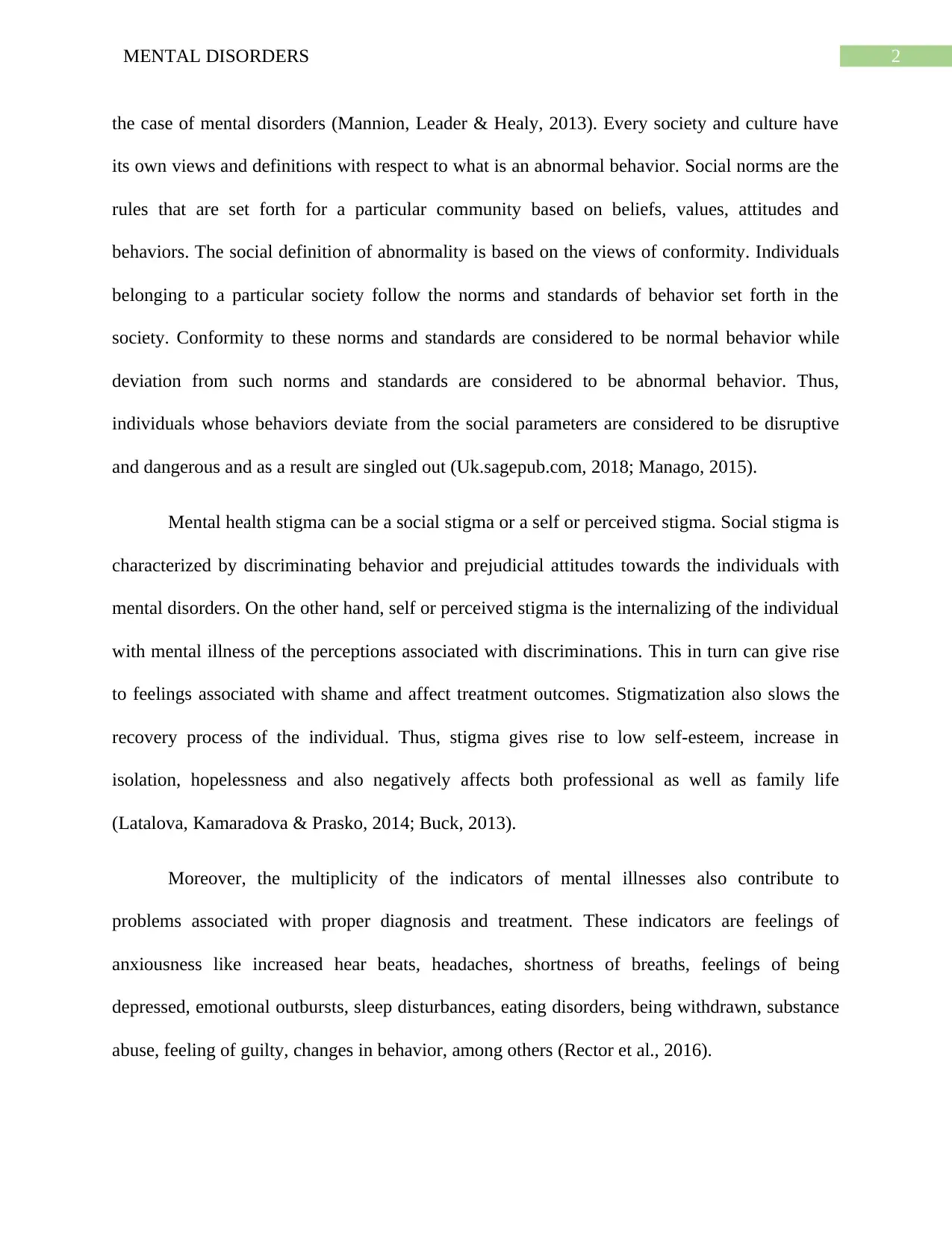
2MENTAL DISORDERS
the case of mental disorders (Mannion, Leader & Healy, 2013). Every society and culture have
its own views and definitions with respect to what is an abnormal behavior. Social norms are the
rules that are set forth for a particular community based on beliefs, values, attitudes and
behaviors. The social definition of abnormality is based on the views of conformity. Individuals
belonging to a particular society follow the norms and standards of behavior set forth in the
society. Conformity to these norms and standards are considered to be normal behavior while
deviation from such norms and standards are considered to be abnormal behavior. Thus,
individuals whose behaviors deviate from the social parameters are considered to be disruptive
and dangerous and as a result are singled out (Uk.sagepub.com, 2018; Manago, 2015).
Mental health stigma can be a social stigma or a self or perceived stigma. Social stigma is
characterized by discriminating behavior and prejudicial attitudes towards the individuals with
mental disorders. On the other hand, self or perceived stigma is the internalizing of the individual
with mental illness of the perceptions associated with discriminations. This in turn can give rise
to feelings associated with shame and affect treatment outcomes. Stigmatization also slows the
recovery process of the individual. Thus, stigma gives rise to low self-esteem, increase in
isolation, hopelessness and also negatively affects both professional as well as family life
(Latalova, Kamaradova & Prasko, 2014; Buck, 2013).
Moreover, the multiplicity of the indicators of mental illnesses also contribute to
problems associated with proper diagnosis and treatment. These indicators are feelings of
anxiousness like increased hear beats, headaches, shortness of breaths, feelings of being
depressed, emotional outbursts, sleep disturbances, eating disorders, being withdrawn, substance
abuse, feeling of guilty, changes in behavior, among others (Rector et al., 2016).
the case of mental disorders (Mannion, Leader & Healy, 2013). Every society and culture have
its own views and definitions with respect to what is an abnormal behavior. Social norms are the
rules that are set forth for a particular community based on beliefs, values, attitudes and
behaviors. The social definition of abnormality is based on the views of conformity. Individuals
belonging to a particular society follow the norms and standards of behavior set forth in the
society. Conformity to these norms and standards are considered to be normal behavior while
deviation from such norms and standards are considered to be abnormal behavior. Thus,
individuals whose behaviors deviate from the social parameters are considered to be disruptive
and dangerous and as a result are singled out (Uk.sagepub.com, 2018; Manago, 2015).
Mental health stigma can be a social stigma or a self or perceived stigma. Social stigma is
characterized by discriminating behavior and prejudicial attitudes towards the individuals with
mental disorders. On the other hand, self or perceived stigma is the internalizing of the individual
with mental illness of the perceptions associated with discriminations. This in turn can give rise
to feelings associated with shame and affect treatment outcomes. Stigmatization also slows the
recovery process of the individual. Thus, stigma gives rise to low self-esteem, increase in
isolation, hopelessness and also negatively affects both professional as well as family life
(Latalova, Kamaradova & Prasko, 2014; Buck, 2013).
Moreover, the multiplicity of the indicators of mental illnesses also contribute to
problems associated with proper diagnosis and treatment. These indicators are feelings of
anxiousness like increased hear beats, headaches, shortness of breaths, feelings of being
depressed, emotional outbursts, sleep disturbances, eating disorders, being withdrawn, substance
abuse, feeling of guilty, changes in behavior, among others (Rector et al., 2016).
⊘ This is a preview!⊘
Do you want full access?
Subscribe today to unlock all pages.

Trusted by 1+ million students worldwide
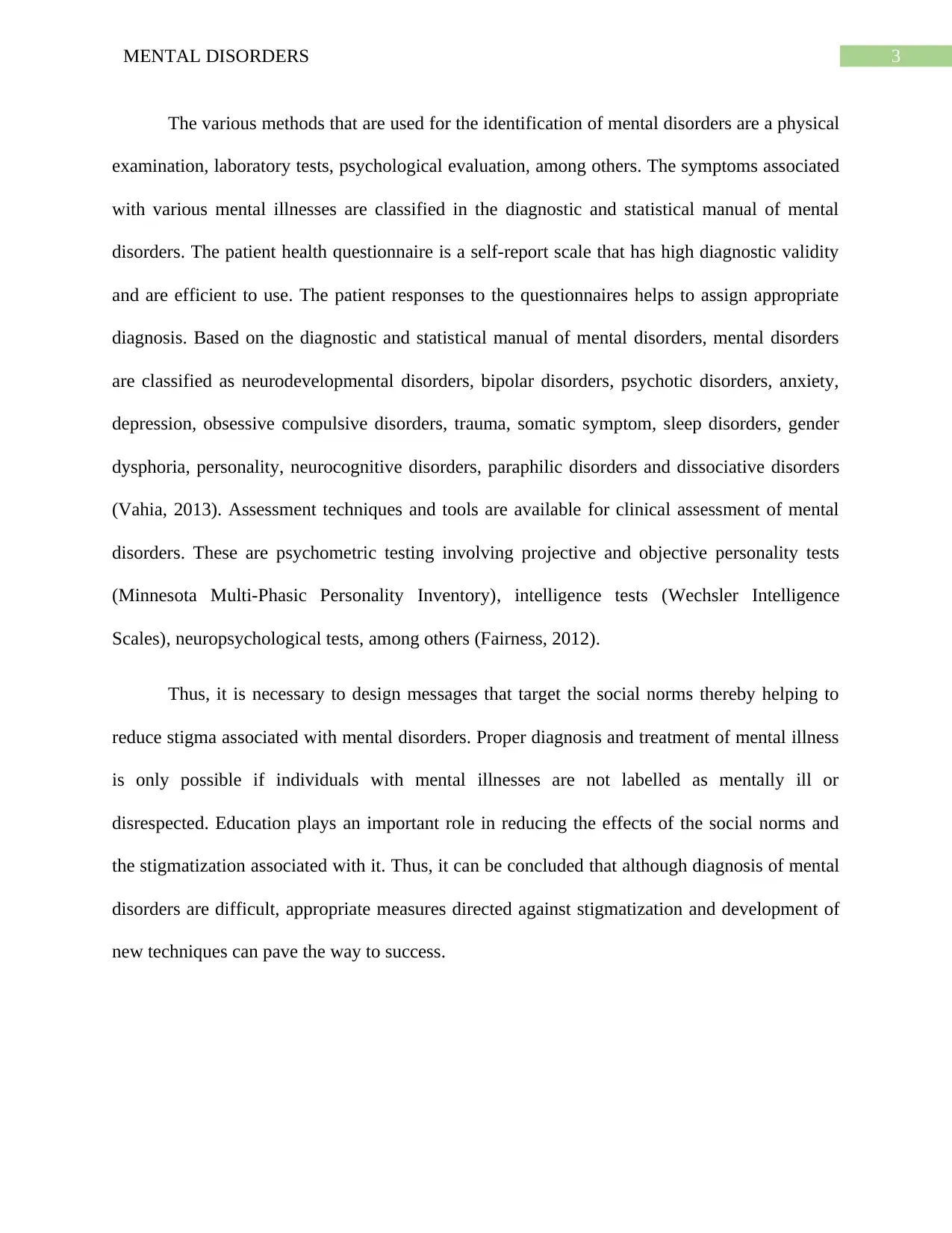
3MENTAL DISORDERS
The various methods that are used for the identification of mental disorders are a physical
examination, laboratory tests, psychological evaluation, among others. The symptoms associated
with various mental illnesses are classified in the diagnostic and statistical manual of mental
disorders. The patient health questionnaire is a self-report scale that has high diagnostic validity
and are efficient to use. The patient responses to the questionnaires helps to assign appropriate
diagnosis. Based on the diagnostic and statistical manual of mental disorders, mental disorders
are classified as neurodevelopmental disorders, bipolar disorders, psychotic disorders, anxiety,
depression, obsessive compulsive disorders, trauma, somatic symptom, sleep disorders, gender
dysphoria, personality, neurocognitive disorders, paraphilic disorders and dissociative disorders
(Vahia, 2013). Assessment techniques and tools are available for clinical assessment of mental
disorders. These are psychometric testing involving projective and objective personality tests
(Minnesota Multi-Phasic Personality Inventory), intelligence tests (Wechsler Intelligence
Scales), neuropsychological tests, among others (Fairness, 2012).
Thus, it is necessary to design messages that target the social norms thereby helping to
reduce stigma associated with mental disorders. Proper diagnosis and treatment of mental illness
is only possible if individuals with mental illnesses are not labelled as mentally ill or
disrespected. Education plays an important role in reducing the effects of the social norms and
the stigmatization associated with it. Thus, it can be concluded that although diagnosis of mental
disorders are difficult, appropriate measures directed against stigmatization and development of
new techniques can pave the way to success.
The various methods that are used for the identification of mental disorders are a physical
examination, laboratory tests, psychological evaluation, among others. The symptoms associated
with various mental illnesses are classified in the diagnostic and statistical manual of mental
disorders. The patient health questionnaire is a self-report scale that has high diagnostic validity
and are efficient to use. The patient responses to the questionnaires helps to assign appropriate
diagnosis. Based on the diagnostic and statistical manual of mental disorders, mental disorders
are classified as neurodevelopmental disorders, bipolar disorders, psychotic disorders, anxiety,
depression, obsessive compulsive disorders, trauma, somatic symptom, sleep disorders, gender
dysphoria, personality, neurocognitive disorders, paraphilic disorders and dissociative disorders
(Vahia, 2013). Assessment techniques and tools are available for clinical assessment of mental
disorders. These are psychometric testing involving projective and objective personality tests
(Minnesota Multi-Phasic Personality Inventory), intelligence tests (Wechsler Intelligence
Scales), neuropsychological tests, among others (Fairness, 2012).
Thus, it is necessary to design messages that target the social norms thereby helping to
reduce stigma associated with mental disorders. Proper diagnosis and treatment of mental illness
is only possible if individuals with mental illnesses are not labelled as mentally ill or
disrespected. Education plays an important role in reducing the effects of the social norms and
the stigmatization associated with it. Thus, it can be concluded that although diagnosis of mental
disorders are difficult, appropriate measures directed against stigmatization and development of
new techniques can pave the way to success.
Paraphrase This Document
Need a fresh take? Get an instant paraphrase of this document with our AI Paraphraser
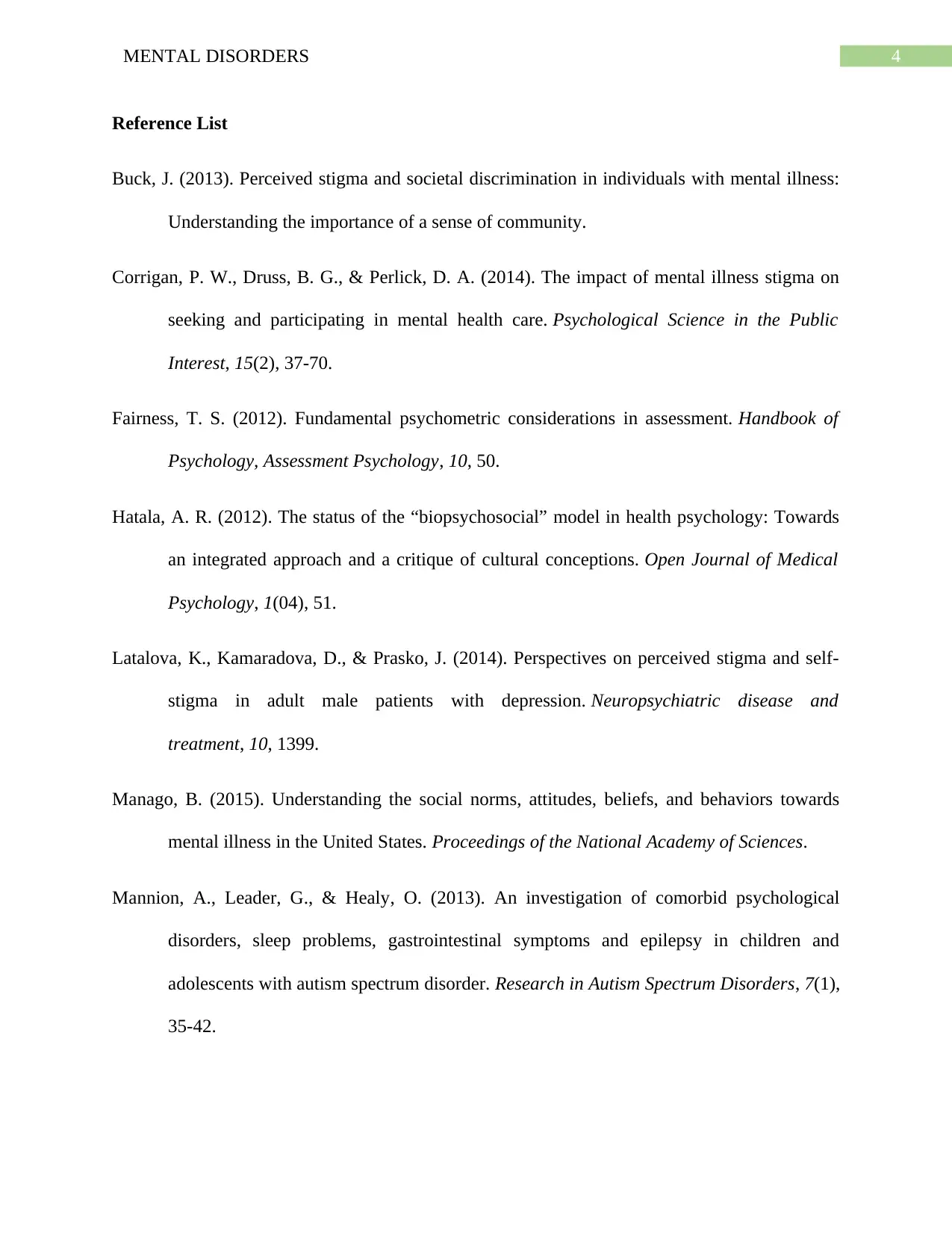
4MENTAL DISORDERS
Reference List
Buck, J. (2013). Perceived stigma and societal discrimination in individuals with mental illness:
Understanding the importance of a sense of community.
Corrigan, P. W., Druss, B. G., & Perlick, D. A. (2014). The impact of mental illness stigma on
seeking and participating in mental health care. Psychological Science in the Public
Interest, 15(2), 37-70.
Fairness, T. S. (2012). Fundamental psychometric considerations in assessment. Handbook of
Psychology, Assessment Psychology, 10, 50.
Hatala, A. R. (2012). The status of the “biopsychosocial” model in health psychology: Towards
an integrated approach and a critique of cultural conceptions. Open Journal of Medical
Psychology, 1(04), 51.
Latalova, K., Kamaradova, D., & Prasko, J. (2014). Perspectives on perceived stigma and self-
stigma in adult male patients with depression. Neuropsychiatric disease and
treatment, 10, 1399.
Manago, B. (2015). Understanding the social norms, attitudes, beliefs, and behaviors towards
mental illness in the United States. Proceedings of the National Academy of Sciences.
Mannion, A., Leader, G., & Healy, O. (2013). An investigation of comorbid psychological
disorders, sleep problems, gastrointestinal symptoms and epilepsy in children and
adolescents with autism spectrum disorder. Research in Autism Spectrum Disorders, 7(1),
35-42.
Reference List
Buck, J. (2013). Perceived stigma and societal discrimination in individuals with mental illness:
Understanding the importance of a sense of community.
Corrigan, P. W., Druss, B. G., & Perlick, D. A. (2014). The impact of mental illness stigma on
seeking and participating in mental health care. Psychological Science in the Public
Interest, 15(2), 37-70.
Fairness, T. S. (2012). Fundamental psychometric considerations in assessment. Handbook of
Psychology, Assessment Psychology, 10, 50.
Hatala, A. R. (2012). The status of the “biopsychosocial” model in health psychology: Towards
an integrated approach and a critique of cultural conceptions. Open Journal of Medical
Psychology, 1(04), 51.
Latalova, K., Kamaradova, D., & Prasko, J. (2014). Perspectives on perceived stigma and self-
stigma in adult male patients with depression. Neuropsychiatric disease and
treatment, 10, 1399.
Manago, B. (2015). Understanding the social norms, attitudes, beliefs, and behaviors towards
mental illness in the United States. Proceedings of the National Academy of Sciences.
Mannion, A., Leader, G., & Healy, O. (2013). An investigation of comorbid psychological
disorders, sleep problems, gastrointestinal symptoms and epilepsy in children and
adolescents with autism spectrum disorder. Research in Autism Spectrum Disorders, 7(1),
35-42.
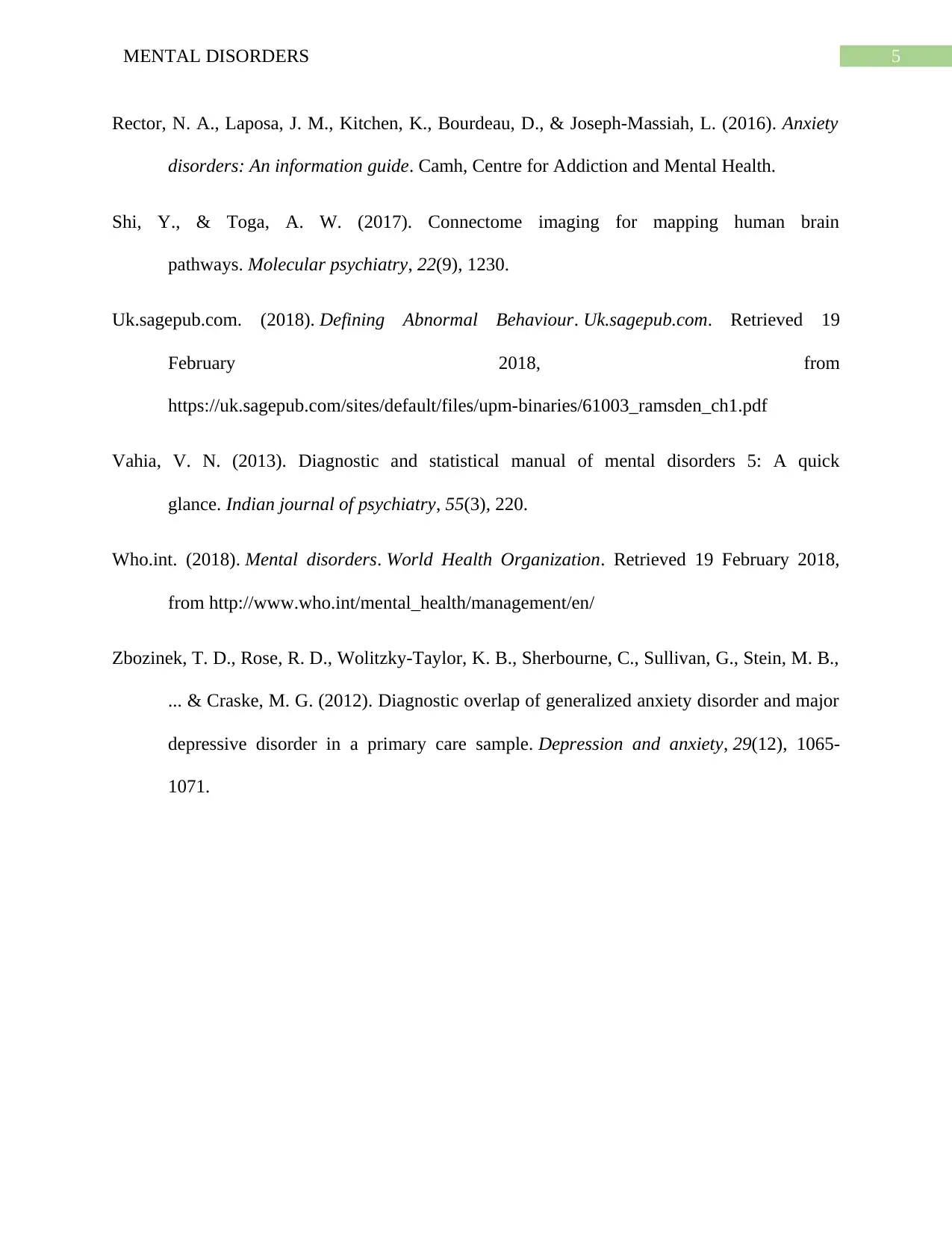
5MENTAL DISORDERS
Rector, N. A., Laposa, J. M., Kitchen, K., Bourdeau, D., & Joseph-Massiah, L. (2016). Anxiety
disorders: An information guide. Camh, Centre for Addiction and Mental Health.
Shi, Y., & Toga, A. W. (2017). Connectome imaging for mapping human brain
pathways. Molecular psychiatry, 22(9), 1230.
Uk.sagepub.com. (2018). Defining Abnormal Behaviour. Uk.sagepub.com. Retrieved 19
February 2018, from
https://uk.sagepub.com/sites/default/files/upm-binaries/61003_ramsden_ch1.pdf
Vahia, V. N. (2013). Diagnostic and statistical manual of mental disorders 5: A quick
glance. Indian journal of psychiatry, 55(3), 220.
Who.int. (2018). Mental disorders. World Health Organization. Retrieved 19 February 2018,
from http://www.who.int/mental_health/management/en/
Zbozinek, T. D., Rose, R. D., Wolitzky‐Taylor, K. B., Sherbourne, C., Sullivan, G., Stein, M. B.,
... & Craske, M. G. (2012). Diagnostic overlap of generalized anxiety disorder and major
depressive disorder in a primary care sample. Depression and anxiety, 29(12), 1065-
1071.
Rector, N. A., Laposa, J. M., Kitchen, K., Bourdeau, D., & Joseph-Massiah, L. (2016). Anxiety
disorders: An information guide. Camh, Centre for Addiction and Mental Health.
Shi, Y., & Toga, A. W. (2017). Connectome imaging for mapping human brain
pathways. Molecular psychiatry, 22(9), 1230.
Uk.sagepub.com. (2018). Defining Abnormal Behaviour. Uk.sagepub.com. Retrieved 19
February 2018, from
https://uk.sagepub.com/sites/default/files/upm-binaries/61003_ramsden_ch1.pdf
Vahia, V. N. (2013). Diagnostic and statistical manual of mental disorders 5: A quick
glance. Indian journal of psychiatry, 55(3), 220.
Who.int. (2018). Mental disorders. World Health Organization. Retrieved 19 February 2018,
from http://www.who.int/mental_health/management/en/
Zbozinek, T. D., Rose, R. D., Wolitzky‐Taylor, K. B., Sherbourne, C., Sullivan, G., Stein, M. B.,
... & Craske, M. G. (2012). Diagnostic overlap of generalized anxiety disorder and major
depressive disorder in a primary care sample. Depression and anxiety, 29(12), 1065-
1071.
⊘ This is a preview!⊘
Do you want full access?
Subscribe today to unlock all pages.

Trusted by 1+ million students worldwide
1 out of 6